1、Step Back Prompting
Take A Step Back: Evoking Reasoning Via Abstraction In Large Language Models
https://arxiv.org/pdf/2310.06117.pdf
这是google deep mind开发的一种方法,它使用LLM来创建用户查询的抽象。该方法将从用户查询中退后一步,以便更好地从问题中获得概述。LLM将根据用户查询生成更通用的问题。
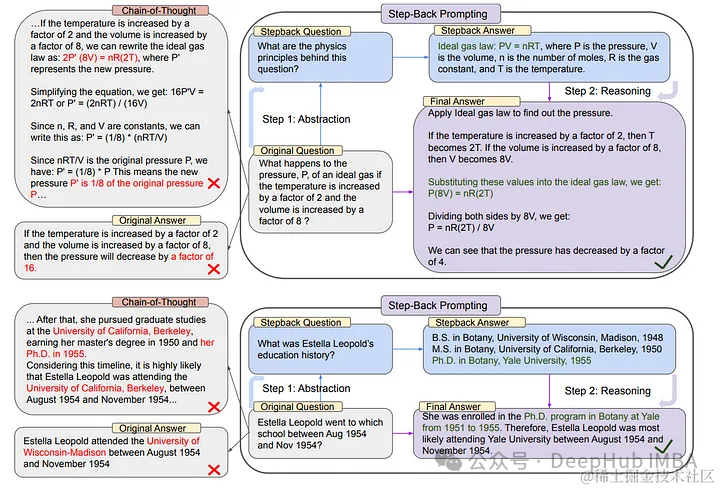
下面是原始查询和后退查询的示例。
{
"Original_Query": "Could the members of The Police perform lawful arrests?",
"Step_Back_Query": "what can the members of The Police do?",
},
{
"Original_Query": "Jan Sindel’s was born in what country?",
"Step_Back_Query": "what is Jan Sindel’s personal history?",
}
下面代码演示了如何使用Langchain进行Step Back Prompting
#---------------------Prepare VectorDB-----------------------------------
# Build a sample vectorDB
from langchain.text_splitter import RecursiveCharacterTextSplitter
from langchain_community.document_loaders import WebBaseLoader
from langchain_community.vectorstores import Chroma
from langchain.embeddings import OpenAIEmbeddings
import os
os.environ["OPENAI_API_KEY"] = "Your OpenAI KEY"
# Load blog post
loader = WebBaseLoader("https://lilianweng.github.io/posts/2023-06-23-agent/")
data = loader.load()
# Split
text_splitter = RecursiveCharacterTextSplitter(chunk_size=100, chunk_overlap=0)
splits = text_splitter.split_documents(data)
# VectorDB
embedding = OpenAIEmbeddings()
vectordb = Chroma.from_documents(documents=splits, embedding=embedding)
#-------------------Prepare Step Back Prompt Pipeline------------------------
from langchain_core.output_parsers import StrOutputParser
from langchain_core.prompts import ChatPromptTemplate, FewShotChatMessagePromptTemplate
from langchain_core.runnables import RunnableLambda
from langchain.chat_models import ChatOpenAI
retriever = vectordb.as_retriever()
llm = ChatOpenAI()
# Few Shot Examples
examples = [
{
"input": "Could the members of The Police perform lawful arrests?",
"output": "what can the members of The Police do?",
},
{
"input": "Jan Sindel’s was born in what country?",
"output": "what is Jan Sindel’s personal history?",
},
]
# We now transform these to example messages
example_prompt = ChatPromptTemplate.from_messages(
[
("human", "{input}"),
("ai", "{output}"),
]
)
few_shot_prompt = FewShotChatMessagePromptTemplate(
example_prompt=example_prompt,
examples=examples,
)
prompt = ChatPromptTemplate.from_messages(
[
(
"system",
"""You are an expert at world knowledge. Your task is to step back and paraphrase a question to a more generic step-back question, which is easier to answer. Here are a few examples:""",
),
# Few shot examples
few_shot_prompt,
# New question
("user", "{question}"),
]
)
question_gen = prompt | llm | StrOutputParser()
#--------------------------QnA using Back Prompt Technique-----------------
from langchain import hub
def format_docs(docs):
doc_strings = [doc.page_content for doc in docs]
return "\n\n".join(doc_strings)
response_prompt = hub.pull("langchain-ai/stepback-answer")
chain = (
{
# Retrieve context using the normal question
"normal_context": RunnableLambda(lambda x: x["question"]) | retriever | format_docs,
# Retrieve context using the step-back question
"step_back_context": question_gen | retriever | format_docs,
# Pass on the question
"question": lambda x: x["question"],
}
| response_prompt
| llm
| StrOutputParser()
)
result = chain.invoke({"question": "What Task Decomposition that work in 2022?"})
在那个脚本中,我们的问题是
Original Query: What Task Decomposition that work in 2022?
Step Back Prompting为
Step Back Query: What are some examples of task decomposition in the current year?
这两个查询将用于提取相关文档,将这些文档组合在一起作为一个上下文,提供给LLM生成最终的答案。
{
# Retrieve context using the normal question
"normal_context": RunnableLambda(lambda x: x["question"]) | retriever | format_docs,
# Retrieve context using the step-back question
"step_back_context": question_gen | retriever | format_docs,
# Pass on the question
"question": lambda x: x["question"],
}
2、 Multi Query
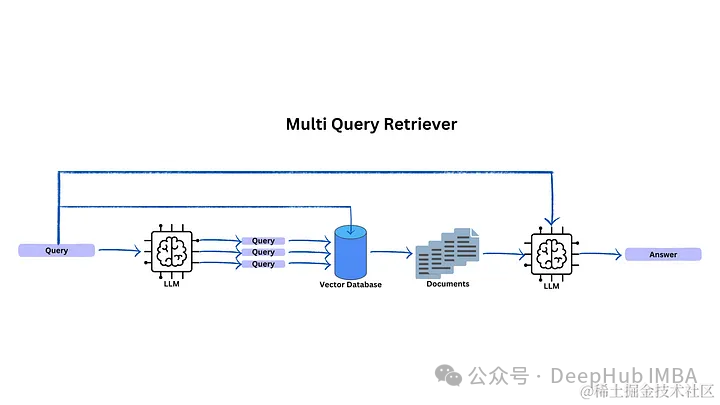
Langchain Multi Query Retriever
https://python.langchain.com/docs/modules/data_connection/retrievers/MultiQueryRetriever
多步查询是一种使用LLM从第一个查询生成更多查询的技术。这种技术试图解决用户提示不是那么具体的情况。这些生成的查询将用于在矢量数据库中查找文档。
多步查询的目标是改进查询,使其与主题更加相关,从而从数据库中检索更多相关的文档。
因为Langchain 有详细的文档,我们就不贴代码了
3、Cross Encoding Re-Ranking
这个方法是多查询和交叉编码器重新排序的结合,当用户使用LLM生成更多的问题时,每个生成的查询都从向量数据库中提取一对文档。
这些提取的文档通过交叉编码器传递,获得与初始查询的相似度分数。然后对相关文档进行排序,并选择前5名作为LLM返回结果。
为什么需要挑选前5个文档?因为需要尽量避免从矢量数据库检索的不相关文档。这种选择确保交叉编码器专注于最相似和最有意义的文档,从而生成更准确和简洁的摘要。
#------------------------Prepare Vector Database--------------------------
# Build a sample vectorDB
from langchain.text_splitter import RecursiveCharacterTextSplitter
from langchain_community.document_loaders import WebBaseLoader
from langchain_community.vectorstores import Chroma
from langchain.embeddings import OpenAIEmbeddings
from langchain.chat_models import ChatOpenAI
import os
os.environ["OPENAI_API_KEY"] = "Your API KEY"
# Load blog post
loader = WebBaseLoader("https://lilianweng.github.io/posts/2023-06-23-agent/")
data = loader.load()
llm = ChatOpenAI()
# Split
text_splitter = RecursiveCharacterTextSplitter(chunk_size=100, chunk_overlap=0)
splits = text_splitter.split_documents(data)
# VectorDB
embedding = OpenAIEmbeddings()
vectordb = Chroma.from_documents(documents=splits, embedding=embedding)
#--------------------Generate More Question----------------------------------
#This function use to generate queries using LLM
def create_original_query(original_query):
query = original_query["question"]
qa_system_prompt = """
You are an AI language model assistant. Your task is to generate five
different versions of the given user question to retrieve relevant documents from a vector
database. By generating multiple perspectives on the user question, your goal is to help
the user overcome some of the limitations of the distance-based similarity search.
Provide these alternative questions separated by newlines."""
qa_prompt = ChatPromptTemplate.from_messages(
[
("system", qa_system_prompt),
("human", "{question}"),
]
)
rag_chain = (
qa_prompt
| llm
| StrOutputParser()
)
question_string = rag_chain.invoke(
{"question": query}
)
lines_list = question_string.splitlines()
queries = []
queries = [query] + lines_list
return queries
#-------------------Retrieve Document and Cross Encoding--------------------
from sentence_transformers import CrossEncoder
from langchain_core.prompts import ChatPromptTemplate
from langchain_core.runnables import RunnableLambda, RunnablePassthrough
from langchain_core.output_parsers import StrOutputParser
import numpy as np
cross_encoder = CrossEncoder('cross-encoder/ms-marco-MiniLM-L-6-v2')
#Cross Encoding happens in here
def create_documents(queries):
retrieved_documents = []
for i in queries:
results = vectordb.as_retriever().get_relevant_documents(i)
docString = format_docs(results)
retrieved_documents.extend(docString)
unique_a = []
#If there is duplication documents for each query, make it unique
for item in retrieved_documents:
if item not in unique_a:
unique_a.append(item)
unique_documents = list(unique_a)
pairs = []
for doc in unique_documents:
pairs.append([queries[0], doc])
#Cross Encoder Scoring
scores = cross_encoder.predict(pairs)
final_queries = []
for x in range(len(scores)):
final_queries.append({"score":scores[x],"document":unique_documents[x]})
#Rerank the documents, return top 5
sorted_list = sorted(final_queries, key=lambda x: x["score"], reverse=True)
first_five_elements = sorted_list[:6]
return first_five_elements
#-----------------QnA Document-----------------------------------------------
qa_system_prompt = """
Assistant is a large language model trained by OpenAI. \
Use the following pieces of retrieved context to answer the question. \
If you don't know the answer, just say that you don't know. \
{context}"""
qa_prompt = ChatPromptTemplate.from_messages(
[
("system", qa_system_prompt),
("human", "{question}"),
]
)
def format(docs):
doc_strings = [doc["document"] for doc in docs]
return "\n\n".join(doc_strings)
chain = (
# Prepare the context using below pipeline
# Generate Queries -> Cross Encoding -> Rerank ->return context
{"context": RunnableLambda(create_original_query)| RunnableLambda(create_documents) | RunnableLambda(format), "question": RunnablePassthrough()}
| qa_prompt
| llm
| StrOutputParser()
)
result = chain.invoke({"question":"What Task Decomposition that work in 2022?"})
从上面代码主要是创建了两个用于生成查询和交叉编码的自定义函数。
create_original_query用于生成查询,它将返回5个生成的问题加上原始查询。
create_documents则根据6个问题(上面的5个生成问题和1个原始查询)检索24个相关文档。这24个相关文档可能重复,所以需要进行去重。
之后我们使用
scores = cross_encoder.predict(pairs)
给出文档和原始查询之间的交叉编码分数。然后就是对文档重新排序,保留前5个文档。
总结
以上就是最常用的3种改进RAG能力扩展查询方法。当你在使用RAG时,并且没有得到正确或详细的答案,可以使用上述查询扩展方法来解决这些问题。希望所有这些技术可以用于你的下一个项目。
如何系统的去学习大模型LLM ?
作为一名热心肠的互联网老兵,我意识到有很多经验和知识值得分享给大家,也可以通过我们的能力和经验解答大家在人工智能学习中的很多困惑,所以在工作繁忙的情况下还是坚持各种整理和分享。
但苦于知识传播途径有限,很多互联网行业朋友无法获得正确的资料得到学习提升,故此将并将重要的 AI大模型资料 包括AI大模型入门学习思维导图、精品AI大模型学习书籍手册、视频教程、实战学习等录播视频免费分享出来。
所有资料 ⚡️ ,朋友们如果有需要全套 《LLM大模型入门+进阶学习资源包》,扫码获取~

一、全套AGI大模型学习路线
AI大模型时代的学习之旅:从基础到前沿,掌握人工智能的核心技能!
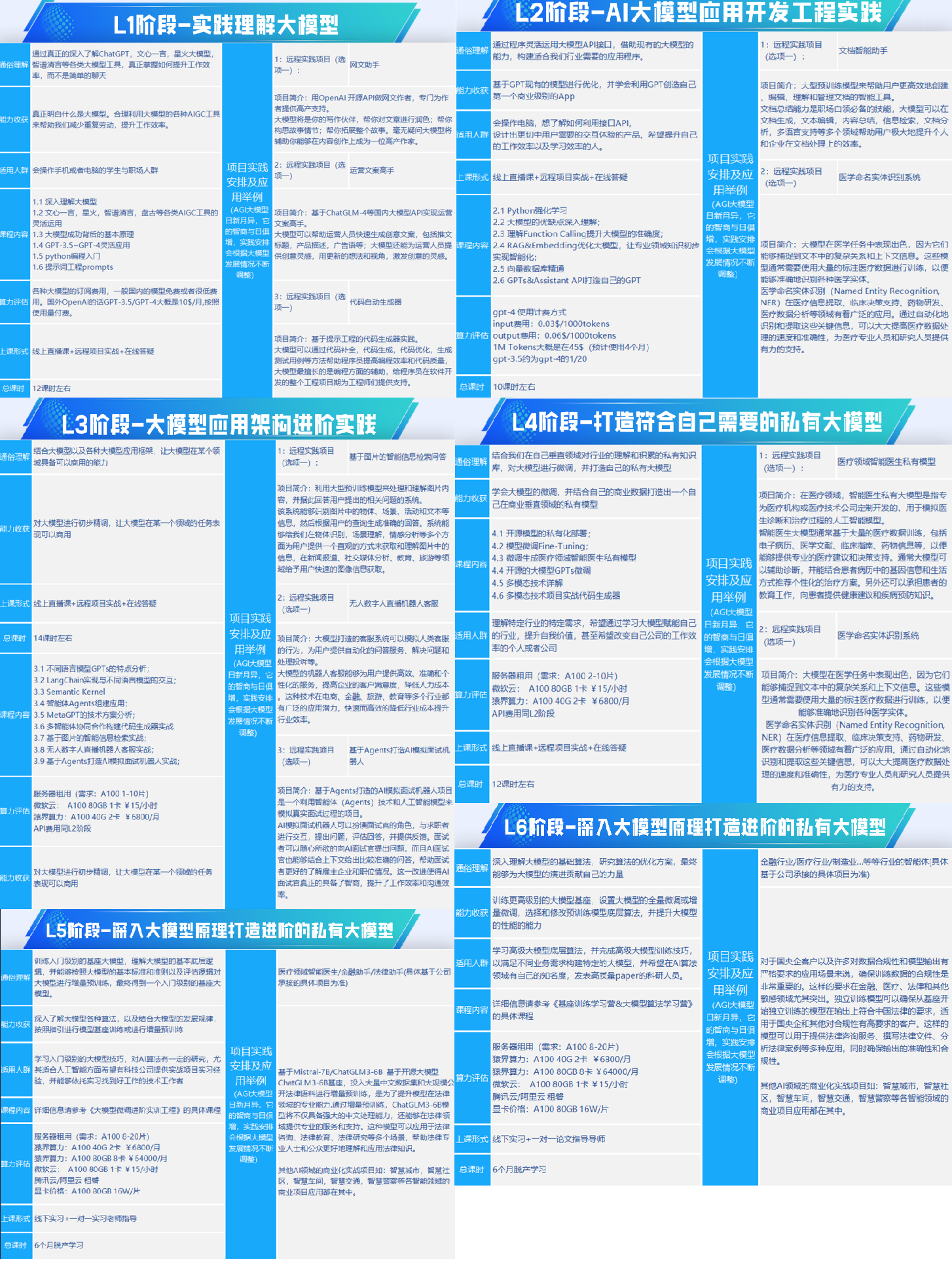
二、640套AI大模型报告合集
这套包含640份报告的合集,涵盖了AI大模型的理论研究、技术实现、行业应用等多个方面。无论您是科研人员、工程师,还是对AI大模型感兴趣的爱好者,这套报告合集都将为您提供宝贵的信息和启示。

三、AI大模型经典PDF籍
随着人工智能技术的飞速发展,AI大模型已经成为了当今科技领域的一大热点。这些大型预训练模型,如GPT-3、BERT、XLNet等,以其强大的语言理解和生成能力,正在改变我们对人工智能的认识。 那以下这些PDF籍就是非常不错的学习资源。
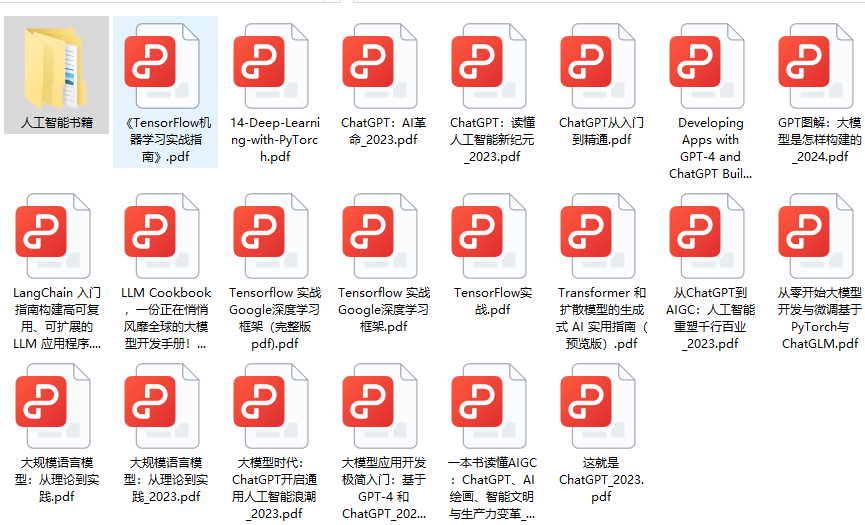
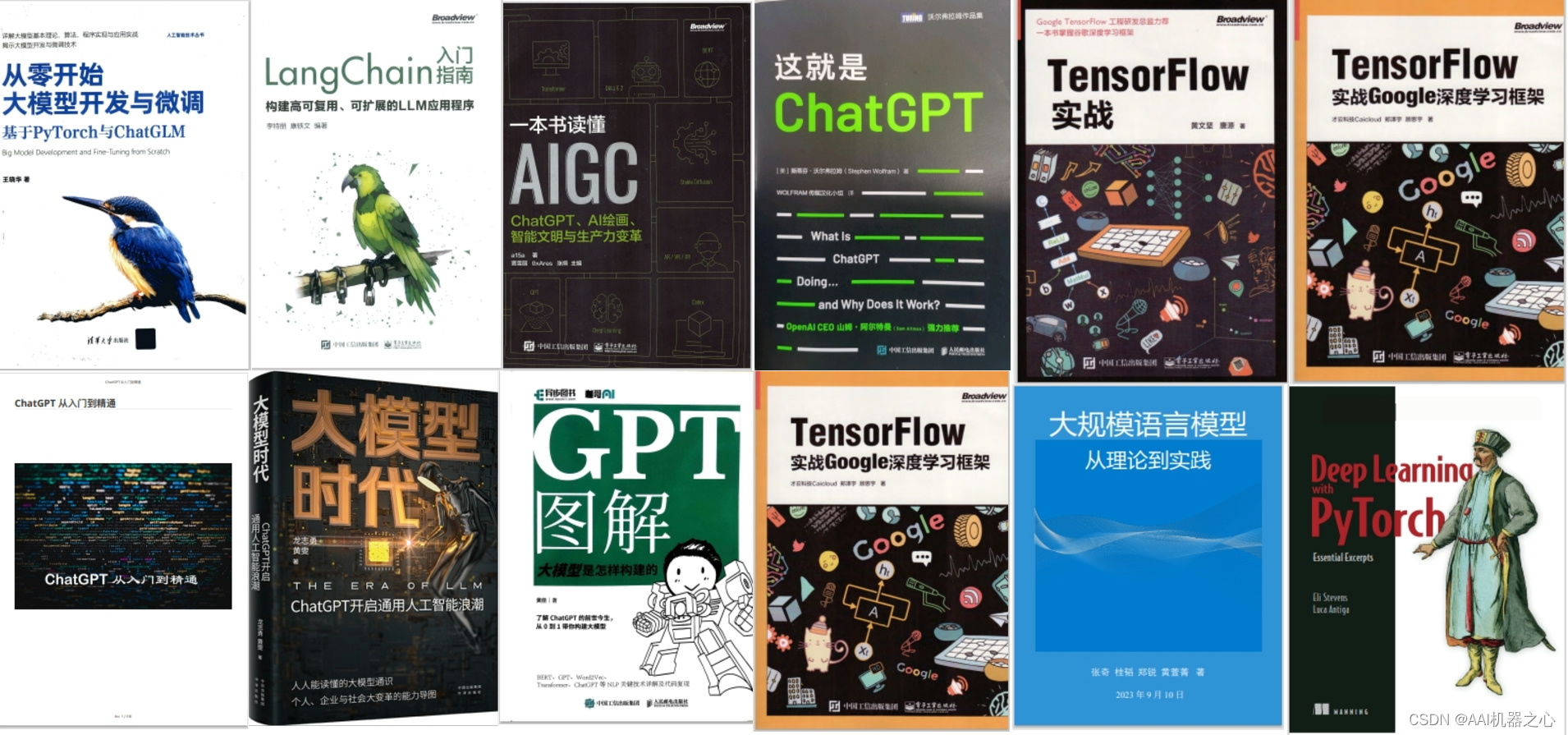
四、AI大模型商业化落地方案

阶段1:AI大模型时代的基础理解
- 目标:了解AI大模型的基本概念、发展历程和核心原理。
- 内容:
- L1.1 人工智能简述与大模型起源
- L1.2 大模型与通用人工智能
- L1.3 GPT模型的发展历程
- L1.4 模型工程
- L1.4.1 知识大模型
- L1.4.2 生产大模型
- L1.4.3 模型工程方法论
- L1.4.4 模型工程实践 - L1.5 GPT应用案例
阶段2:AI大模型API应用开发工程
- 目标:掌握AI大模型API的使用和开发,以及相关的编程技能。
- 内容:
- L2.1 API接口
- L2.1.1 OpenAI API接口
- L2.1.2 Python接口接入
- L2.1.3 BOT工具类框架
- L2.1.4 代码示例 - L2.2 Prompt框架
- L2.2.1 什么是Prompt
- L2.2.2 Prompt框架应用现状
- L2.2.3 基于GPTAS的Prompt框架
- L2.2.4 Prompt框架与Thought
- L2.2.5 Prompt框架与提示词 - L2.3 流水线工程
- L2.3.1 流水线工程的概念
- L2.3.2 流水线工程的优点
- L2.3.3 流水线工程的应用 - L2.4 总结与展望
- L2.1 API接口
阶段3:AI大模型应用架构实践
- 目标:深入理解AI大模型的应用架构,并能够进行私有化部署。
- 内容:
- L3.1 Agent模型框架
- L3.1.1 Agent模型框架的设计理念
- L3.1.2 Agent模型框架的核心组件
- L3.1.3 Agent模型框架的实现细节 - L3.2 MetaGPT
- L3.2.1 MetaGPT的基本概念
- L3.2.2 MetaGPT的工作原理
- L3.2.3 MetaGPT的应用场景 - L3.3 ChatGLM
- L3.3.1 ChatGLM的特点
- L3.3.2 ChatGLM的开发环境
- L3.3.3 ChatGLM的使用示例 - L3.4 LLAMA
- L3.4.1 LLAMA的特点
- L3.4.2 LLAMA的开发环境
- L3.4.3 LLAMA的使用示例 - L3.5 其他大模型介绍
- L3.1 Agent模型框架
阶段4:AI大模型私有化部署
- 目标:掌握多种AI大模型的私有化部署,包括多模态和特定领域模型。
- 内容:
- L4.1 模型私有化部署概述
- L4.2 模型私有化部署的关键技术
- L4.3 模型私有化部署的实施步骤
- L4.4 模型私有化部署的应用场景
学习计划:
- 阶段1:1-2个月,建立AI大模型的基础知识体系。
- 阶段2:2-3个月,专注于API应用开发能力的提升。
- 阶段3:3-4个月,深入实践AI大模型的应用架构和私有化部署。
- 阶段4:4-5个月,专注于高级模型的应用和部署。
这份完整版的所有 ⚡️ 大模型 LLM 学习资料已经上传CSDN,朋友们如果需要可以微信扫描下方CSDN官方认证二维码免费领取【保证100%免费】
全套 《LLM大模型入门+进阶学习资源包》↓↓↓ 获取~






















 394
394

 被折叠的 条评论
为什么被折叠?
被折叠的 条评论
为什么被折叠?








